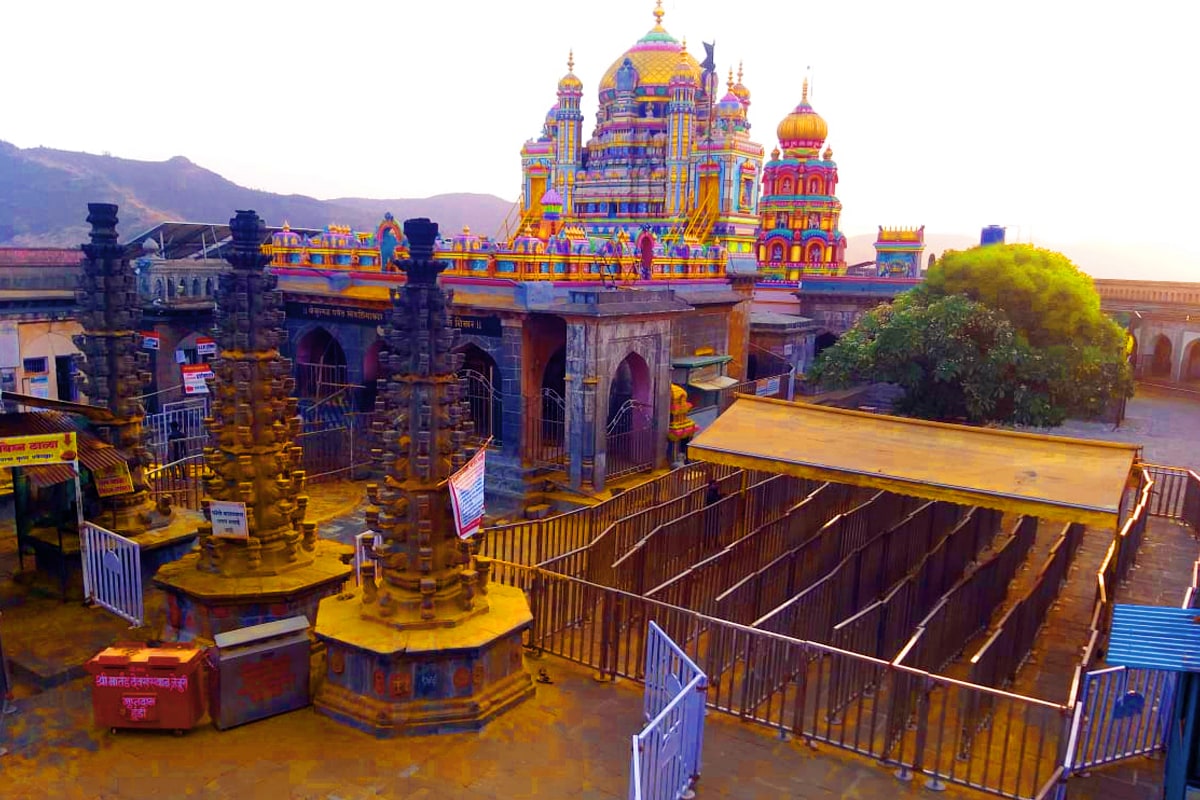Jejuri Khandoba Temple- Maharashtra

Address
Jejuri Khandoba Temple- Jejuri, Pune district Maharashtra 412303
Diety
Khandoba (Martanda Bhairava) Amman: Parvati
Introduction
Khandoba Temple is located in the city of Jejuri in Pune. It is the prime temple among the Khandoba (Martanda Bhairava) Temples across Maharashtra. In fact, there are two shrines on top of a hill in Jejuri: one is Kadepathar and another is Gad-kot Temple. Jejuri city is famous for the temple of Lord Khandoba, situated 48 km from Pune on Pune Pandharpur road at hill top. Lord Khandoba also known as Martanda Bhairava or Malhari Martand, There are over 500 temples dedicated to Lord Khandoba in India.
Puranic Significance
Folklore says Khandoba is a warrior king and a form (incarnation) of Lord Shiva. Some Sanskrit versions recognize him as Martanda Bhairava, a fusion of Bhairava (the fierce form of Lord Shiva) and Martanda, the solar deity. Though there are many versions of Khandobas tales, he is one of the prominent Gods worshipped in Maharashtra. As said earlier, there are many versions of the legends relating to Martanda Bhairava. One or two myths are very famous and are associated with the creation of this temple. One of the major sources is the literary work, Malhari Mahatmya. Lord Khandoba is also known as Malhari (the warrior king). According to this literary work, the battle between Khandoba and the demons called Malla and Mani is the prime story behind the birth of Lord Martanda Bhairava. The tale says that, the demon-brothers named Malla and Mani were creating havoc in the world as they had got a boon from Lord Brahma. All Gods got annoyed by the menace they were creating on earth but were not able to destroy them. So, they requested Lord Shiva to destroy these demons. It is then Khandoba (a form of Shiva) was born. Finally, Malla and Mani were killed in the battle; while dying Mani asked for forgiveness by offering his white horse to Khandoba and gain a boon to be in every shrine of Martanda Bhairava. In fact, the name Malhari or Mallari comes from the words ‘Malla’ and ‘ari’ which means the destroyer of Malla or the enemy of Malla. Khandoba has two wives who are women from different communities, who serve as cultural links between the god and the communities. He has two wives, Mhalsa and Banai (Banu, Banubai) being the most important. While Khandoba’s first wife Mhalsa is from the Lingayat merchant (Vani) community, his second wife Banai is a Dhangar (shepherd caste). Mhalsa has had a regular ritualistic marriage with Khandoba. Banai, on the other hand, has a love marriage by capture with the god. Mhalsa is described as jealous and a good cook; Banai is resolute, but does not even know how to cook. Often folk songs tell of their quarrels. Mhalsa represents “culture” and Banai “nature”. The god king Khandoba stands between them. Mhalsa is believed to be a combined avatar of Parvati. Mhalsa was born as the daughter of a rich merchant in Newase called Tirmarsheth. On the divine orders of Khandoba in a dream to Tirmarsheth, she was married to Khandoba on Pausha Pournima (the full moon day of Hindu calendar month of Paush) in Pali (Pembar). Two shivlingas appeared on this occasion. Banai is believed to the daughter of Brahma, the creator, Incarnation of Goddess Ganga. Banai was found by Dhangar shepherd. When Banai grew up, it was predicted that she would get her match at Jejuri. There, she fell in love with God Khandoba. Khandoba also fell in her love. Khandoba accepted a self-exile for 12 years by intentionally losing a game of chess (Saripat) to his wife Mhalsa. He took disguise of shepherd and started serving Banai’s father. One day, Khandoba killed all the sheep and goats of Banai’ father and promised to make them alive again if he was married to Banai. The reluctant Banai was married to Khandoba, the shepherd in disguise at Naldurg. Khandoba revealed his real form to Banai on their way back to Jejuri. On reaching Jejuri, Khandoba was greeted by Mhalsa’s fury and her strong protest of his second marriage. To avoid the quarrels of his wives, Khandoba gave the upper half of the hill to Mhalsa and the lower half to Banai. The idol of Mhalsa is placed with Khandoba in the main shrine at top of the hill at Jejuri. A separate shrine to Banai is situated halfway down the hill.
Beliefs
It is believed that Khandoba is a god of Sakamabhakti, the God never fails to fulfill the desires of devotees who visit the shrine with true devotion and abiding faith.
Special Features
The temple is situated on the hill top. One has to climb around 300 steps to reach the temple. The entire temple surrounding is full yellow. Khandoba’s main consort is Mhalsa an incarnation of Goddess Parvati. Legend says he has another 4 consorts as well. Khandoba avatar was born to destroy the demon Malla and Mani. Jejuri is famous for its Bhandara festival, which draws close to six lakh devotees when the temple town erupts in celebrations. Amidst riotous showers of haldi or turmeric popularly called ‘bhandara’ devotees make their way up a steep hill to the top.
Festivals
Six-day festival in the month of Margashira, Dasara and Chaitra Purnima and Bandara festival are the famous festivals celebrated in Khandoba Temple. Khandoba Navaratri is celebrated during November end.
Century/Period/Age
1000- Years old
Managed By
Archaeological Survey of India (ASI)
Nearest Bus Station
Jejuri
Nearest Railway Station
Jejuri Station
Nearest Airport
Pune









